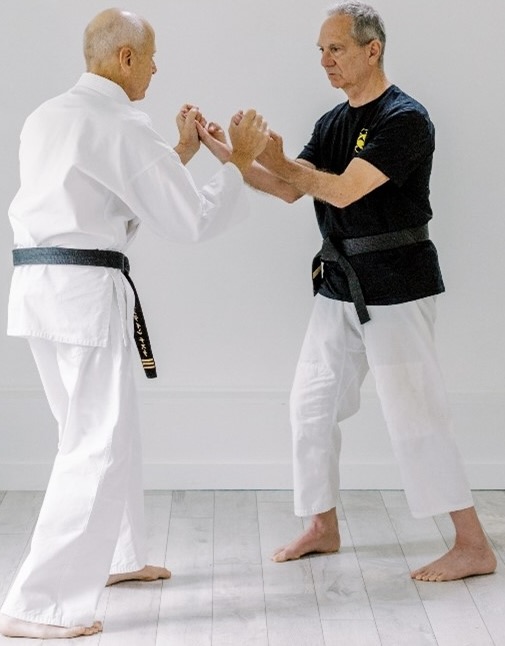Sanchin Shime, or testing, is a drill involving two people. A teacher, senior, or peer conducts the test to check the karateka’s structure, balance, and concentration. This involves introducing various checks at key points around the body, whether the karateka is stationary or in motion. In karate, specifically Sanchin, shime translates to “lockdown” or “tighten up” and relates to refining and fixing posture, techniques, and positions. However, testing has evolved to focus more on the karateka’s ability to take hard punches and kicks to various muscle groups.
Sensei Mattson reflects that he was never “tested” by being struck by Master Tomoyose or Master Uechi, but that he and the other young students would challenge each other with intense hitting while performing Sanchin kata in the back of the dojo. When Sensei Mattson opened his first school in Boston, hard testing became a popular demonstration to attract new students, and eventually, it became part of class and promotional testing. Over the decades, hard Sanchin testing has become a hallmark of Uechi-Ryu karate.
In his article, “Sanchin, Shime and Hard Impact,” in the Fighting Arts online magazine, Kris Wilder concludes, “The percussive striking of modern-day Sanchin testing is not traditional and is not a pathway for success. In fact, it’s a modern affectation and lacks understanding of the goal of shime testing.” Wilder continues to explain, “The old method of testing Sanchin kata is that of a building load and not percussion. The testing is built around allowing the student to study their body and the teacher teaching the student.” The distinction that Wilder makes between building load versus percussion is significant. Building load is a gradual building of intensity that improves strength and endurance over time. Percussion refers to the forceful impact of striking action on the body. Building load is the preferred method of testing.
Engaging in intense testing or even just anticipating such testing can lead the karate practitioner to develop muscle memory to remain tense under stress. High-impact testing can result in rigidity and impaired breathing and is not constructive. Furthermore, strikes to the abdomen and other muscle groups pose a risk of trauma. Powerful strikes and kicks to the arms and legs can cause long-term joint injuries.
It is often claimed that experiencing physical impact is an integral part of preparing for self-defense or participating in free-style sparring matches, as such situations usually involve being hit. While it is true that one is likely to endure physical impact in self-defense and sparring scenarios, the high risks associated with such impacts on the body suggest that it is better to enhance the body’s musculature through supplementary exercises and learn how to breathe and activate the core correctly. However, regardless of one’s level of physical conditioning, critical body targets like the eyes, throat, liver, spleen, solar plexus, and groin cannot be shielded by muscles.
Proper and safe checking (testing) of Sanchin kata can be an excellent tool for the karate practitioner’s development and a way for the instructor to provide feedback. The “checking” process should help the student develop body flow, posture, balance, breathing, core activation, and accuracy. Another advantage of correct Sanchin checking is that it allows the practitioner to become less sensitive to disruptions during the kata, promoting a mindset of calmness and control.
During testing, gently touch, push, and pull without punching or kicking. Apply increasing pressure slowly (build the load), primarily with an open hand, although a closed fist may be appropriate in certain situations. The intensity of the pressure applied at the checkpoints should be aligned with the student’s experience level.
When conducted with supportive guidance, Sanchin testing helps students identify weaknesses and areas for improvement, enabling continuous growth and development. Practitioners can develop a deep understanding of the complexities of Sanchin kata and refine their techniques, leading to mastery of form, breathing patterns, and calmness under pressure.
Justin Testa


